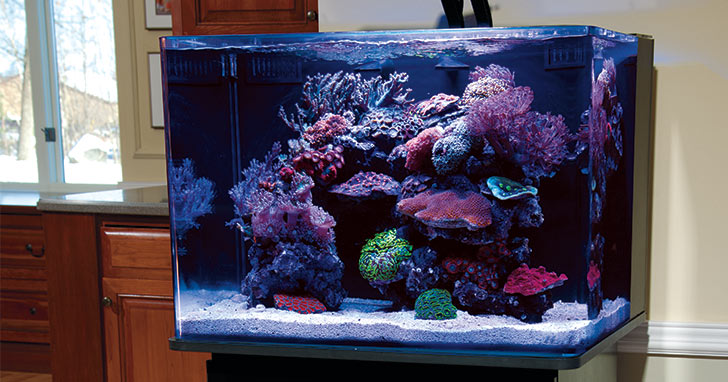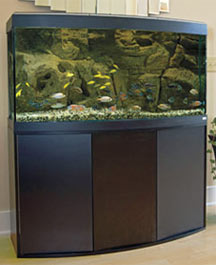
Successful aquariums depend greatly on research and preparation. Just as you research the care requirements of the fish you are interested in, you will also need to think about fundamental aspects such as aquarium placement. Before you install your new aquarium, consider aquarium placement and size to avoid laborious and costly mistakes.
Location, location, location
An aquarium placed in a back room or basement may not receive the care or attention it needs. Oftentimes a poorly located aquarium can result in neglect, increasing risk of fish disease or equipment malfunction that remains unnoticed. Set up your aquarium where you spend most of your time. By doing so, you can fully enjoy the results of your endeavor. Choose a room where you will be able to view and take pleasure in your aquatic system. But more importantly, place the aquarium where it is easily accessible for regular and convenient maintenance.
Keep in mind, once fully set up, aquariums weigh at least 10 pounds per gallon. In other words, even a 10-gallon aquarium will weigh a cumbersome 100 pounds! So, choose the location carefully to avoid stressful and unnecessary relocation.
Your aquarium needs a "space bubble"
Just as people need adequate space around them, your aquarium needs sufficient space around it for routine cleaning and maintenance. Do not block equipment or areas you need to access frequently such as the back of the aquarium for filtration and the top of the aquarium for water changes and lighting. If you are planning to place aquarium equipment in a cabinet or stand, make sure that it has adequate ventilation. This helps control mold and other cultures that thrive in humid areas and also keeps heat buildup to a minimum.
 Are electrical outlets and a water source nearby?
Are electrical outlets and a water source nearby?
Electric outlets need to be close enough that you can plug in aquarium equipment without having to use extension cords. A distance of no further than 3 ft away is best. The extra cords are not only a tripping hazard but a tangle of equipment cords is a serious electrical hazard. If possible, locate your aquarium close to your water supply to make crucial water changes and other aquarium maintenance easier for you.
Are heat/AC vents or exterior entrances nearby?
Heating and air conditioning vents, as well as exterior entrances, can drastically alter the temperature in the immediate surrounding area. Stable water temperature is imperative to fish health, so make sure to place your aquarium away from these areas. It is also very important to keep your aquarium out of direct sunlight. Exposure to direct sunlight can encourage
aggressive algae growth, as well as increased water temperatures.
Will your aquarium and stand be in a stable and level location?
Examine the floor in the area you plan to locate your aquarium and stand. Check to see if it "gives" under the weight of your body. Using a level, test to see whether the flooring is level and even. If part of the stand is on a hard surface (a hardwood floor) and the other is on a soft surface (a padded carpet) you'll need to check the level of the aquarium stand with some weight placed on it to get a true sense. If it is not level, a shim can be used to make up for the small difference but only for smaller aquariums. A surface that isn't level makes it impossible to totally fill your aquarium, but more importantly, an aquarium that is not level is more inclined to tip over or spring a leak.
Size limitations
In general, the bigger the aquarium, the better it is for your fish. Greater water volume dilutes toxin concentration, providing some leeway to less than perfect water conditions. Also, larger aquariums allow greater variety of fish to peacefully cohabitate with each other in a stable and healthy environment. However, the tricky thing about larger aquariums is that most residential flooring is intended for humans and their furniture. A 30-gallon aquarium weighing approximately 300 pounds should not pose a structural problem, especially if placed against a weight-bearing wall. But for aquariums larger than 30-gallons, ask yourself this question, "Will the floor be able to support the weight of the aquarium once it is set-up?" If you have any doubt, consult and verify with a professional to make sure your flooring is capable of supporting the weight of the aquarium.
Give some thought before setting up and installing your new aquarium. Something as basic as proper aquarium placement is the difference between an enjoyable aquarium hobby and a neglected eyesore. |




